5 Marketing Automation Tools in 2025 to know
Looking for a perfect marketing automation tools 2025? How do you know what suits you the best? Compare & find the best automation tool for you.
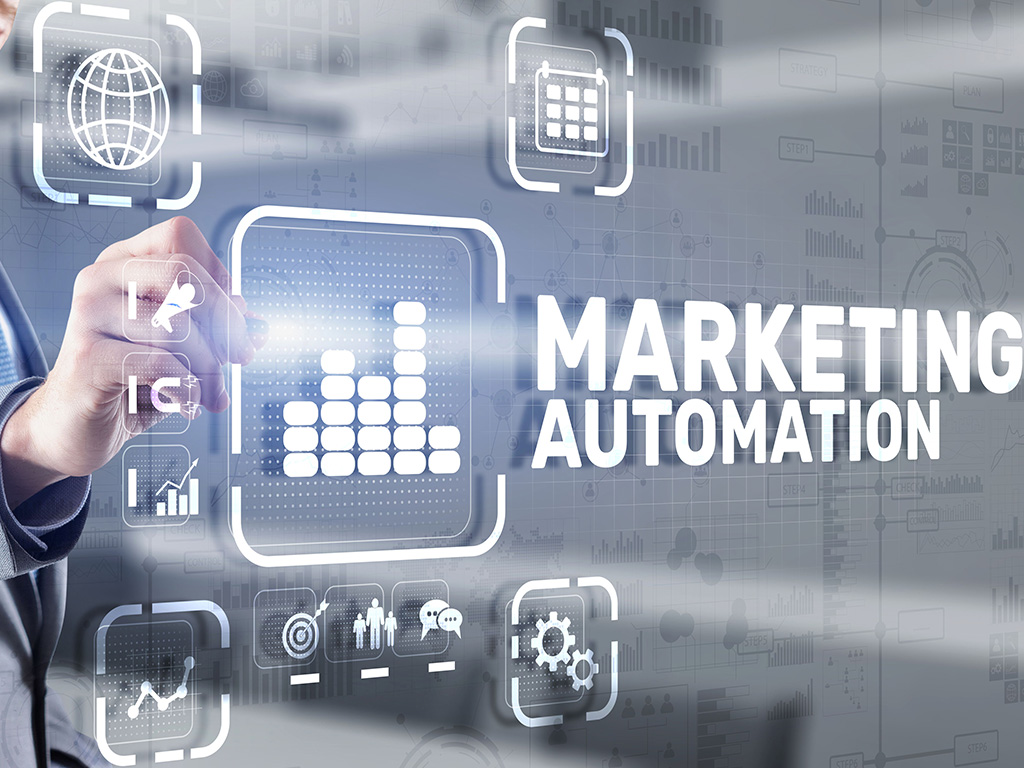
Table of Content:
- What marketing technologies will dominate 2025?
- What is Automation Tool in Marketing?
- What are the 4 types of Automation?
- What are the 5 basic elements of Automation?
- Why marketing automation is a must in your 2025 strategy?
- Top Marketing Automation Tools in 2025
- Future Trends of Marketing Automation Tools
What marketing technologies will dominate 2025?
We are at the cusp of a new technological revolution, shaped by our worldly woes, especially in direct response to the hiatus we experienced a few years back. With the continuous doom & gloom of international conflicts, the looming pandemic, and the impending recession, marketers are ever more effervescent in their approach to treating uncertainty. Still reeling from the effects, today, business owners and decision-makers are aggressively looking for solutions to help them future-proof their businesses while riding the current tide to stay afloat.
Enterprises and growth marketers have always prepared for such interruptions and cessations. These unconformities result in breakthrough technology. Businesses will vouch for this. A study by PwC reports that over 52% of companies have invested in digital transformation. Microsoft alone experienced a surge in usage of Zoom & Teams. Deloitte reports that 67% of businesses increased their investments in AI/ML during the pandemic. A separate Gartner report states that there has been a 31% increase in AI-related job postings on LinkedIn.
The last decade focused heavily on Artificial Intelligence, Machine Learning, Big Data, and Analytics; this decade offers something new. Automation in Marketing have marked the advent of 2025. AI-based text and design generators are everywhere today on the internet. Automation is no longer a buzzword but, instead, a competitive advantage.
But wait! There’s more!
Everyone is dealing with data today. Data is the digital currency for the marketing ecosystem. All our technologies since the last decade have been designed to handle data. Capturing data and then running predictive analysis to forecast trends and project customer behavior remained crucial. But GDPR and other compliance regulations have reformed how enterprises handle and operate data.
What does this mean?
It means we can no longer rely on 3rd Part Data sources today. The deprecations on 3rd party data sources mean that marketers will lose the granularity they once had in deciphering user behavior.
Where does this all lead to?
Because we can no longer decipher user patterns and trends solely based on 3rd Party Data sources, we need to ensure that the marketing automation must focus on creating more personalized outreach programs.
It brings us to the highlight of this blog. Marketing automation has been built to extend what artificial intelligence and machine learning have been trained on. To curate automation that is hyper-personalized. That is why marketing automation tools will dominate the market for years.
Wondering if marketing automation is a good or bad idea? Read and find out:
Marketing Automation: A Good or a Bad idea?
What is Automation Tool in Marketing?
Automation tools in marketing are designed and developed with a single objective, automate redundant and repetitive tasks free of human intervention. Depending on the tool, one can use this automation applications to manage daily tasks related to marketing.
Today, the market is overrun by numerous marketing automation tools. And while, some of them might have subtle differences and nuances to conduct a specific marketing task, majority of these tools have most of the features in common. Some of the common daily tasks most of these automation tools perform are email marketing, behavioral targeting, segmenting, running predictive analysis, forecasting trends, prioritizing leads, and personalizing advertisements and call-to-actions.
In a B2B sphere, the marketing automation tools are used to sift through the data to pick up anomalies, trends, and patterns. These are often translated into actionable insights. Marketing automation tools enable marketers to achieve a data-driven approach where every decision and action is backed by data suggestions.
Here is a simple use case of marketing automation tool for delivering the leads for your lead-gen campaign:
A Case Study of Implementing Marketing Automation Tool for Delivering Leads for a campaign.
Problem Statement: While delivering the leads for a campaign of a said client, a good number of leads were found dead and inaccurate. At the same time, some of the leads were not nurtured properly for conversion. The client asked to assess the quality of leads and segment them according to their probability of conversion.
Challenges: Manual bifurcation of leads is error-prone. In-effective lead scoring methods meant the poor quality of delivery. Also, not following up with the leads as per their stage in their buying journey meant no personalization of communication. Hence, no nurturing and warming of leads.
Solutions: Implementing a Marketing Automation Tool resulted in sifting and segmenting the leads according to their buying intentions. Segmentation of the leads is done as per their conversion probability which involves at what stage the buyers are at. Therefore, automated, and personalized nurturing campaigns with hyper-specific CTAs resonated better with the buyer. And finally, ensuring an effective lead scoring method to prioritize leads with better chances of conversion.
Results: The company triggered highly-effective and laser-specific communication by correlating the buyer intent. Whenever the intent peaked, the tool sent automated emails to ensure maximum conversion. Sifting of the data and segmentation according to categories enabled a higher conversion ratio. Sales were increased by 50%, and costs were reduced by 33%. Also, the tool enabled workflow streamlining, meaning more productivity and efficiency.
Marketing Automation is a vast field. If you are looking to get in-depth knowledge of marketing automations, give this blog a read.
Ultimate Guide to B2B Marketing Automation Solutions.
What are the 4 types of Automation?
Most of the marketing automation tools are built and based on some form of automation. The types of automation implemented in design of these tools specify the usage of the tools, and make for their features. Broadly, automations are classified into 4 different categories:
Fixed Automation: This type of automation is used for the mass production of a single product. The equipment is set up to perform a specific task or sequence of tasks, and it cannot be easily reprogrammed or reconfigured.
Programmable Automation: This type of automation is used for the production of smaller batches of different products. The equipment can be reprogrammed to perform different tasks or sequences of tasks, but it still requires human intervention to set up and configure.
Flexible Automation: This type of automation is used for the production of a wide range of products with varying requirements. The equipment is designed to be reprogrammed and reconfigured quickly and easily, and it can adapt to different products and production volumes.
Intelligent Automation: This type of automation uses advanced technologies like artificial intelligence (AI), machine learning (ML), and natural language processing (NLP) to automate complex tasks that require decision-making and cognitive capabilities. It can learn from experience and make decisions based on data and insights, making it highly efficient and adaptable.
Every marketing automation tool is built on one of these four types of automation. Or it can be even a combination of two or more types.
If you are looking to implement marketing automation into your workflow, there are certain guidelines that you need to follow. Prioritizing data before anything else and preparing for a slow rollout are crucial. What else do you need to keep in mind?
Find out: Proven Tech Tips to Implement Marketing Automation.
What are the 5 basic elements of Automation?
There are 5 basic elements in an automated ecosystem that dictate how the process will be conducted. Any automation tool is built around these. Understanding the interplay between these elements will give you an overview as how Automation tools perform what they are intended to perform. Mind well, these are for marketing automation tools and not for mechanical actions. Hence, factors like power supply and actuators are excluded in the discussion.
The 5 basic elements of automation are discussed below:
Control System: A control system is the processing unit of the automation system. It receives inputs, processes them, and then generates output to conduct the necessary operation for the system.
Programming: These are the set of instructions coded in a machine language like ladder logic, function block diagrams, or even high-level language such as C++ or Python.
Human-Machine Interface: HMI is a graphical user interface that allows the user to interact with the platform.
Feedback Loop: Feedback is used to monitor the performance of the system and make adjustments, as necessary. Feedback can be provided by the analytics devices that detect changes in the system’s behavior and provide information to the control system, which can then make adjustments to maintain optimal performance.
Why marketing automation is a must in your 2025 strategy?
It won’t come as a surprise when we say that the market size of the global marketing automation software & tools is expected to grow at a CAGR of 9.8% from 2020 to 2027. Grand View Research reports that the total valuation of the global market for the automation tools is going to be worth USD 8.42 billion by that time.
In another report, EmailMonday suggested that around 61% of the total B2B companies are using some sort of marketing automations to streamline their process. Whereas Ascend2 reports that 69% of the companies have reported improved lead generation, 50% enhanced lead nurturing, and increased customer retention of 47%.
This isn’t just stat padding. A deeper meaning lies latent in these stats. These numbers and figures suggest that marketing automation is necessary in all your strategies going forward. Failing to comply to this trend is going to cost dearly.
To fully leverage the power of marketing automation and maximize the potential of your 2025 marketing strategy, consider adopting all-in-one marketing automation software like Adplorer. This software offers a comprehensive suite of tools and features designed to streamline your marketing efforts and enhance campaign performance. By embracing Adplorer and similar all-in-one solutions, you can stay ahead of the competition, optimize your marketing endeavors, and achieve remarkable results in this fast-paced digital landscape.
Marketing automations can help you:
- Boost the performance of your campaigns!
- Streamline internal workflows!
- Boost operational efficiency & productivity!
- Increase customer engagement!
- Automate redundant tasks!
- Remove repetition!
- Trigger personalized communication for lead nurturing!
- Acquire data-driven insights and actionable analytics!
Learn more about the benefits of marketing automation tools.
Top Marketing Automation Tools in 2025
Now that you are aware of the benefits of the marketing automation tools, let us find out which of these will really come handy. Feel free to browse through them and explore what suits you the best. The list has been curated from personal experience of using these tools. So, without further ado, let’s dive into this.
Here are the Top 5 Marketing Automation Tools in 2025 you must know about:
5. ActiveCampaign:
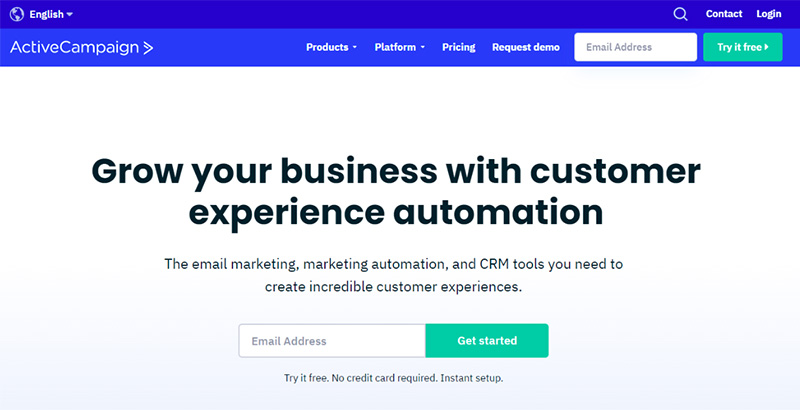
ActiveCampaign is an all-in-one marketing automation tool designed to assist marketers in creating tailored campaigns and cultivating lasting relationships with customers. This platform offers seamless workflow creation and management, real-time customer behavior monitoring, lead tracking, campaign optimization, and many other features to help streamline marketing processes.
ActiveCampaign is a all-in-one marketing automation tool perfect for delivering tailored marketing campaigns.
4. OmniSend
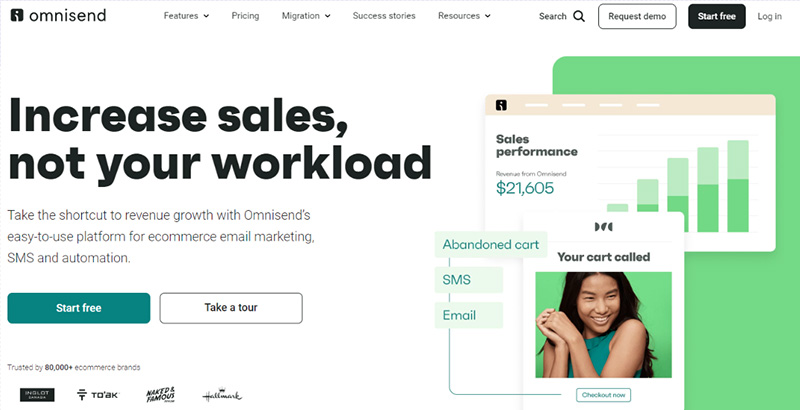
OmniSend is a comprehensive marketing automation platform that is specifically designed to assist marketers in creating and optimizing their campaigns for optimal success. This platform enables marketers to effortlessly segment their customers based on their preferences and activity, efficiently manage customer profiles, track leads, and utilize a range of other features to streamline their marketing processes.
OmniSend, one of the popular marketing automation tools is perfect for segmenting your customer based on their preferences.
3. Salesforce
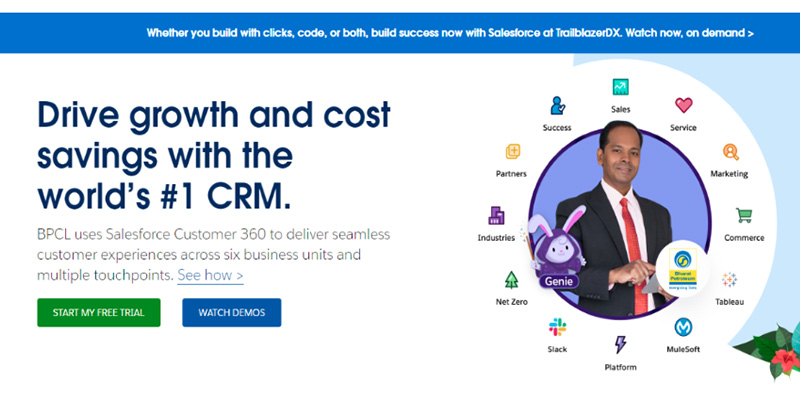
Salesforce is a robust marketing automation platform that empowers marketers to manage their customer relationships and automate their marketing operations. This platform facilitates the creation of personalized emails, tracking of website activity, lead scoring, customer segmentation based on behavior and preferences, and other capabilities that streamline marketing processes.
If you are looking to set up marketing automation in Salesforce, this is how you do it.
How to set up marketing automation in Salesforce?
Popular among marketers Salesforce offers marketing automation plug-ins that are second to none.
2. Mailchimp

Mailchimp is a user-friendly marketing automation platform that simplifies the creation of tailored emails and amplifies easy tracking of customer activity. It is a top marketing automation tool that enables marketers to effortlessly segment their customer base based on their interests and preferences, optimize campaigns to achieve maximum success, and benefit from a range of other features that streamline the marketing process.
A top marketing automation tool for email marketing, MailChimp is widely popular and offers a wide range of utilities.
1. Adobe Marketo
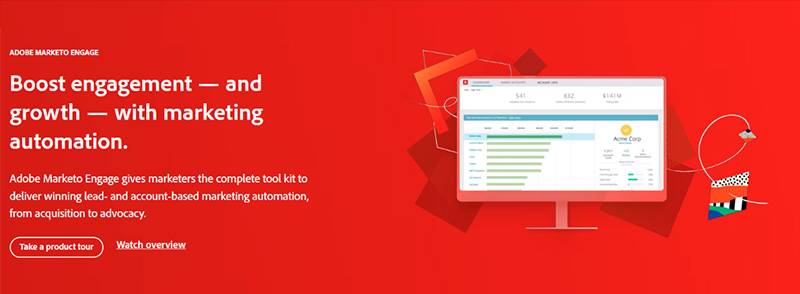
The Marketo marketing automation platform boasts a plethora of robust features, including email marketing automation, lead scoring, customer segmentation, and analytics tracking, to name but a few. Marketo’s multifaceted capabilities enable marketers to seamlessly generate personalized emails and refine their campaigns to maximize efficacy.
Adobe Marketo is often regarded as the best marketing automation tool. From lead scoring to analytics tracking, it offers a plethora of usability with easy-to-use interface.
Future Trends of Marketing Automation Tools
Firstly, it is evident that artificial intelligence and machine learning will continue to play an increasingly important role in marketing automation. According to a report by MarketsandMarkets, the AI in marketing market size is expected to grow from USD 1.5 billion in 2020 to USD 10.3 billion by 2025, at a Compound Annual Growth Rate (CAGR) of 46.2%.
By using these technologies, marketers can analyze customer data and create personalized messaging that resonates with individual customers, driving engagement and building stronger relationships.
Another trend that is predicted to gain traction is omnichannel marketing. By leveraging multiple channels, such as email, social media, and messaging apps, businesses can engage customers across different touchpoints, creating a more seamless and personalized experience.
In addition, personalization will remain a crucial element of marketing automation, with businesses using data and analytics to deliver targeted content to customers. A study by Epsilon found that personalized emails have an open rate 29% higher than non-personalized ones, showing the importance of personalization in driving engagement and conversions.
And lastly, it is highly-likely that cloud-based solutions will continue to become more accessible and affordable, allowing small and mid-sized businesses to benefit from marketing automation in a cost-effective way.
According to a report by MarketsandMarkets, the marketing automation market size is expected to grow from USD 3.3 billion in 2019 to USD 6.4 billion by 2024, at a CAGR of 13.9%, with cloud-based solutions driving growth in the market.
Final Verdict
Marketing automation tools are just starting to take flight. Harnessing this key technology at an early stage is a gamechanger and is sure to have a long-lasting impact on how you perceive your business. With a flurry of such tools in the market, now is the time to hook on to some of the tools, you think is best suited to your business. Now that you know the best marketing automation tools in the market, it’s time you try them out!
Happy Automating your Marketing Process-flow!



